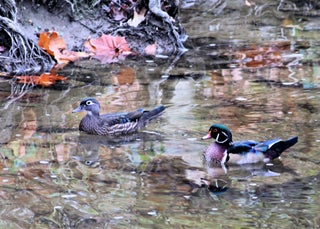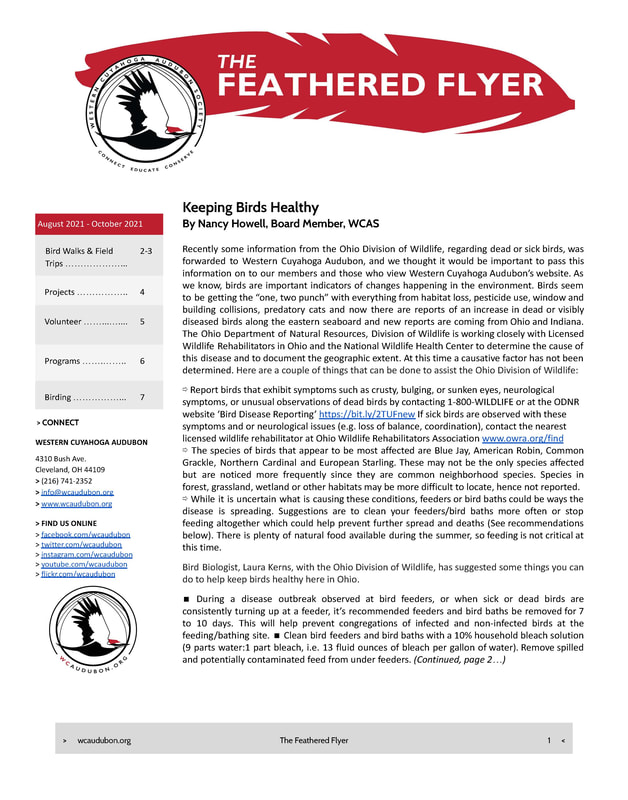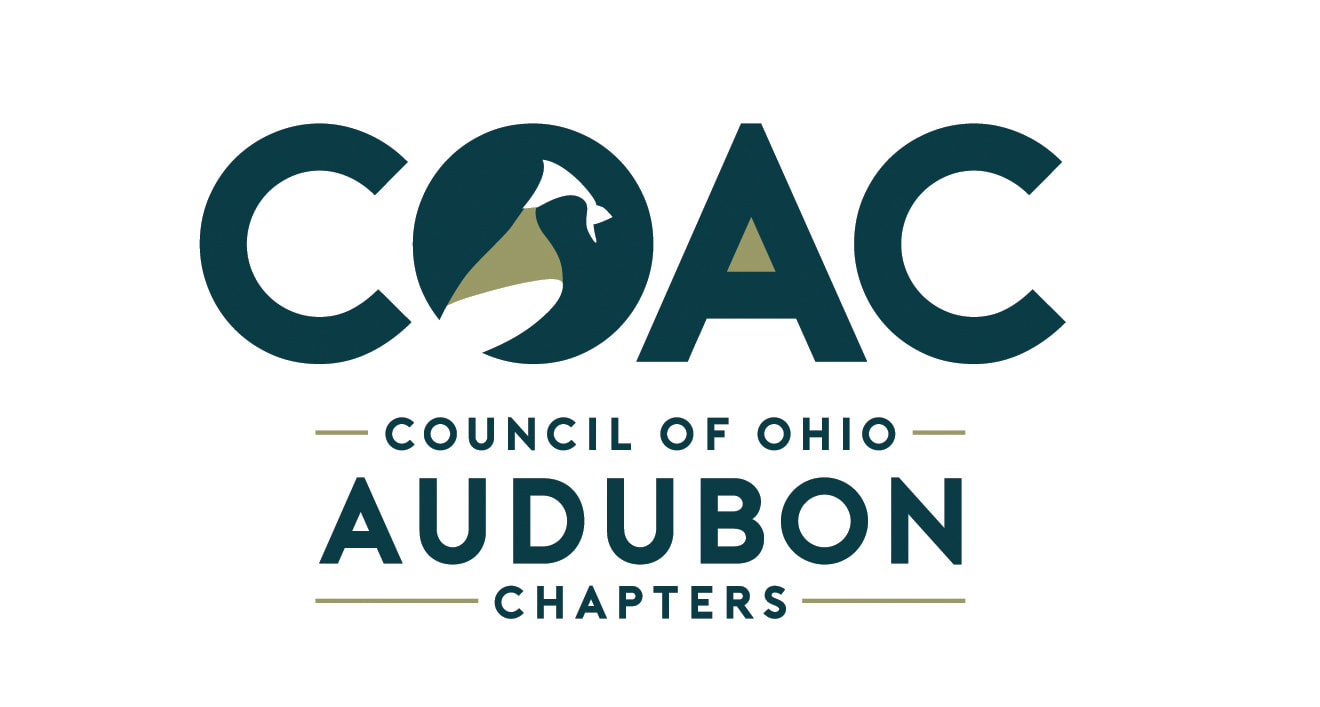Aptly named, Wood Ducks or Woodies, are ducks that like swampy forests as well as marshes. They easily perch in trees and can even cling to the side of a tree, woodpecker-like, for a short time due to long nails on their toes. OCTOBER BIRD OF THE MONTH: Wood Duck Aix sponsa is the scientific name of the Wood Duck, considered by many to be the most beautiful duck in North America. So why start off with the scientific name, because it translates into “waterbird dressed for the wedding”. How beautiful is that? Truly, Wood Ducks are beautiful. Slightly smaller in size and slimmer in shape than a Mallard, both male and female Wood Duck are ready for a wedding with plenty of color and lovely patterns. Male Wood Ducks have iridescent purple-green heads with long, almost flowing feathers extending down the back of the head. White markings and chin straps complete the feather coloration, but what also jumps out is the bright red eye and even the skin around the eye is red. The beak is colored in a pattern of red, white, yellow and black … have you ever noticed? The bird’s back and wings appear black, but in the right light they shine an iridescent blue-green. Males also sport a rust colored, spotted breast and flanks that are tan with the finest of black lines. Some black and white accents can be seen near the breast, along the flanks, and on the primary wing feathers. Female Wood Ducks are a beautiful brown-gray, with white around the large, dark eye. She also has slightly longer feathers on the back of her head. Iridescent wing feathers with some white decorations complete her outfit. Subtle beauty. Wood Ducks are common nesters in northern Ohio, but this was not always the case. Market hunting, wetland drainage and removal of forests all played a part in the collapse of Wood Duck populations in the late 19th century. Fortunately, laws were passed to stop market hunting and hunting during breeding season, wetlands were protected and restored, and forests, especially trees with cavities were allowed to stand. But additional assistance was given to Wood Ducks. Since they are cavity nesters, they readily will nest in man-made nest boxes. Whether constructed out of wood, metal or other material, Wood Ducks took to these boxes, just as Eastern Bluebirds accept bluebird boxes. Wood Duck nesting boxes may be seen at some of the local county parks out in ponds and wet wooded areas. Aptly named, Wood Ducks or Woodies, are ducks that like swampy forests as well as marshes. They easily perch in trees and can even cling to the side of a tree, woodpecker-like, for a short time due to long nails on their toes. Their slim bodies and long tails help them fly and maneuver through stands of trees. As noted earlier, Wood Ducks nest in tree cavities, either broken branch stubs, or holes made by large woodpeckers and squirrels, since the ducks themselves cannot create their own nest cavity. These cavities may be 20 feet or higher from the ground, not a problem as an adult duck, but what about the ducklings that hatch in that cavity? No doubt you’ve seen nature shows showing a Wood Duck hen calling to her recently hatched ducklings who peer out of the nest cavity …. then leap out of the cavity with tiny wings and feet spread and landing either on the forest floor or in the water. The ducklings are so lightweight and the spread wings and feet slow them down a bit so injuries are rare. Wood Ducks, like most other dabbling ducks, are omnivorous, feeding on a variety of plant leaves, roots, seeds, nuts, fruits and tubers, but will also consume aquatic and terrestrial invertebrates, such as worms, snails and various larvae. As summer progresses, young birds are growing but the adult birds begin to molt. All flight feathers are lost at the same time so Wood Ducks seem to become scarce as they retreat to wetlands that provide cover since they cannot fly. Male Wood Ducks lose their colorful plumage and molt into “eclipse plumage”, nearly the same coloration as the females. Fall is the season when Woodies, like many birds, begin their southward migration. Northeast Ohio will have some Wood Ducks that remain throughout the winter … or are they birds that have come from areas further north? Finding Woodies in the winter is not easy although area Christmas Bird Counts will report a few birds. Throughout the winter in their southern haunts, male Woodies again get their lovely plumage so in the early spring, as they begin to arrive in breeding areas, they are handsome for the ladies to choose who will be her mate. Keep an eye out for Wood Ducks, the ducks of summer … but you never know when a beautiful pair will surprise you in the winter. WCAS Bird-of-the-Month Fundraiser October 2020 Each month WCAS features a different bird species to help raise awareness of birds through conservation education. Read this month's featured story about the OCTOBER BIRD OF THE MONTH: Wood Duck by Nancy Howell, Board Member, WCAS. Make a donation to the Bird-of-the-Month Fundraising Goal of $100.00US. Any person who donates to Bird of the Month can be eligible for quarterly raffle prizes. Donations support chapter conservation education efforts. Photo: Wood Ducks by Tom Fishburn.
Comments
|
Story BlogThe Feathered Flyer blog publishes human interest stories about birding and habitat conservation. After watching, ‘My Painted Trillium Quest' by Tom Fishburn, Kim Langley, WCAS Member said, “Wonderful! It was a lift just knowing that such a site exists and is being protected!”
Media LibrariesQuarterly NewsletterSTORIESPodcastsWCAS is a proud member of The Council of Ohio Audubon Chapters (COAC) and promotes chapter development by sharing the best practices, brainstorming solutions to common problems, and building relationships in workshops and retreats. Subscribe
VideosYouth
Advocacy
Clean Energy
Reporting
Awards
Volunteerism
Take ActionResourcesBlogsArchives
October 2023
Categories
All
|
EDUCATENews Blog
Monthly Speakers Field Reports Bird Walk Reports Christmas Bird Count-Lakewood Circle Media Library Newsletter Archive Education Resources STORE |
Western Cuyahoga Audubon Society
4310 Bush Avenue Cleveland, Ohio 44109 [email protected] Western Cuyahoga Audubon Society is a 501(c)(3) nonprofit organization. Your donation is tax-deductible. The tax ID number is: 34-1522665. If you prefer to mail your donation, please send your check to: Nancy Howell, Western Cuyahoga Audubon Treasurer, 19340 Fowles Rd, Middleburg Hts, OH 44130. © 2020 Western Cuyahoga Audubon Society. All rights reserved. Privacy Policy | Terms of Use | Legal | Store Shipping Rates | Site Map |











 RSS Feed
RSS Feed

